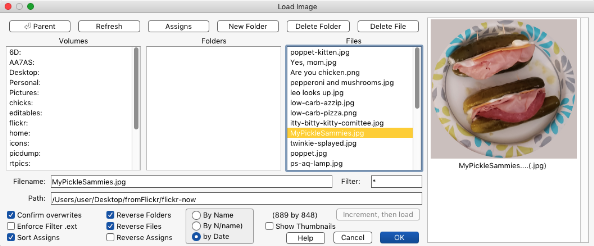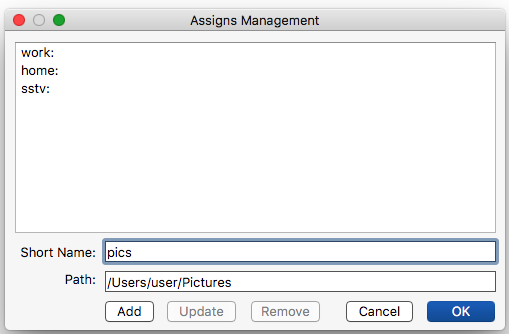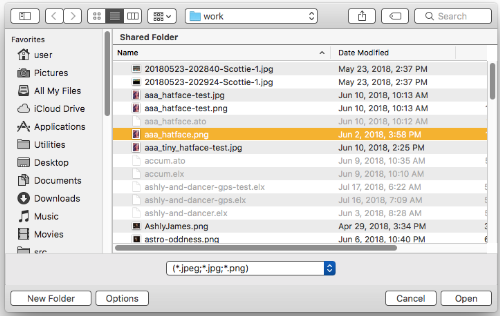§ 22 - File Dialog
iToolBox offers a custom file dialog that is better at handling files in some ways than the native file dialog.
Advantages of the custom file dialog:
- Much faster than the native OS X (MacOS) file dialog
- Hides (not just "dims") files you don't need to see with the Filter control
- Lists folders and volumes separately from files so they don't clog up the file list
- Accepts enter paths and filenames from the keyboard
- Can define single-click custom locations assigns in the filesystem
- Can auto-increment numbered filenames on saves
- Can show thumbnails of more images types: image masters and layers, palettes, ranges, etc.
- Displays the pixel resolution of selected images
- Easily and directly navigates the entire filesystem, including the LAN
§ 22.0.1 - Parent
<-- Parent takes you one step back up the folder tree in the filesystem. You can go all the way to the root of the filesystem this way.
§ 22.0.2 - Refresh
If you know (or surmise) that the filesystem has changed — new files, fewer files, new or removed folders and/or volumes — then you can press Refresh and the dialog will refresh with the current state of the filesystem.
§ 22.0.3 - Assigns
Assigns allows you to create virtual filesystem roots that will appear in the volumes list. This provides a means to set working folders you can get to instantly:
An assign consists of two pieces of information. First, a "short name" that will appear in the volumes list in the File dialog, and second, a path that is associated with that short name. So, for instance, you can create a path to your Pictures folder at /Users/John Doe/Pictures with a short name of pics:
When you click on pics: in your volume list, the File dialog immediately loads up the folders and files at /Users/John Doe/Pictures — that's all there is to it. It's a significant timesaver.
You can either add a new assign, or remove / update existing assigns. If you cancel the dialog, all of your changes are discarded. If you click okay in the assigns dialog, but then cancel the File dialog, your changes are not discarded.
When the assigns dialog opens, the path is set to the filesystem location the File dialog was looking at. So all you have to do to make that an assign is enter a short name for that path and click Add
Assigns have priority over volumes in the volume list; assigns appear first.
The assigns feature incorporates the following intuitive behaviors:
- Clicking on an existing assign loads the short name and path into the text boxes
- If there is no short name provided, you can't add, update or remove
- If there is no path provided, you can't add, update or remove
- If the short name does not match any existing one, you can't remove
- If the path is the same as the existing one for an existing shortname, you can't update
- If the shortname is the same as an existing one, you can't add
- Assign short names always have a trailing : character. If you don't provide it, it will be added
§ 22.0.4 - New Folder
Allows you to create a new folder in the current filesystem location.
§ 22.0.5 - Delete Folder
Allows you to delete the folder the dialog is currently examining. This is dangerous. Because it is dangerous, it will prompt you twice to make sure you meant to do this. Once the current folder, all its files, and all the folders that were inside it are deleted, the file dialog will be set to the parent of that folder.
§ 22.0.6 - Delete File
Allows you to delete the currently selected file.
§ 22.0.7 - Volumes List
The volumes list contains a list of volumes (and assigns, if you have created any.) The volumes list is refreshed each time the dialog opens, or when you click Refresh, so you can avoid filesystem hiding newly created files and newly mounted volumes from you.
§ 22.0.8 - Folders List
The folders list contains a list of only folders. This makes navigation much faster and easier than a mixed files + folders approach as used in the native file dialog. The folders list is refreshed each time the File dialog opens, or when you click Refresh, so you can avoid filesystem hiding newly created files from you.
§ 22.0.9 - Files List
The files list contains a list of only files.
This is the first of two features that makes navigation much faster and easier than a mixed files + folders approach as used in the OS X (MacOS) native file dialog. The files list is refreshed each time the dialog opens, or when you click Refresh, so you can avoid filesystem hiding newly created files and newly mounted volumes from you.
The second feature that makes finding your files much easier is the ability to hide files using the Filter control; typing *.png into the Filter box will cause the File dialog to display only files that end with .png, which can reduce clutter and confusion as opposed to simply "dimming" files that don't match the filter as the native OS X (MacOS) dialog does.
§ 22.0.10 - Filename
This is where you can type in a new filename when you are saving an image, or if you already know the filename, you can just type it in here instead of picking it from the list.
§ 22.0.11 - Path
This is where you can type in a path if you already know it. It will change automatically as you navigate the filesystem folder tree using the Folders list.
§ 22.0.12 - Filter
You can use an asterisk ( * ) as a wildcard here. So typing *test* will display all files that have the string "test" in them. To list all files of one type, use, for example, *.png
§ 22.0.13 - Show Thumbnails
Some images can take a long time to generate thumbnails for. If thumbnail generation is taking too much time, you can turn it off by unchecking ✓ Show Thumbnails
§ 22.0.14 - Confirm Overwrites
✓ Confirm overwrites tells the File dialog that if you elect to save a file over an already existing file, you will be warned about it.
§ 22.0.15 - Enforce Filter .ext
✓ Enforce Filter file ext. tells the File dialog that when you are writing out a file, that it must end with the extension in the Filter box. For instance, if you have *.png in the Filter box, and you try to save a file called foo, it will actually be saved as foo.png
§ 22.0.16 - Sort Assigns
✓ Sort Assigns tells the file dialog to sort the assigns portion of the list of volumes alphabetically.
§ 22.0.17 - Reverse Folders
✓ Reverse Folders reverses the alphabetical order of the folder list.
§ 22.0.18 - Reverse Files
✓ Reverse Files reverses the order of the file list, regardless of how it is sorted.
§ 22.0.19 - Reverse Assigns
✓ Reverse Assigns reverses the alphabetical order of the assigns in the volumes list.
§ 22.0.20 - File List Sorting
![]() By Name imposes an alphabetic sort, case-sensitive.
By Name imposes an alphabetic sort, case-sensitive.
![]() By N/name imposes an alphabetic sort, not case-sensitive.
By N/name imposes an alphabetic sort, not case-sensitive.
![]() by Date imposes a sort by the file date.
by Date imposes a sort by the file date.
§ 22.0.21 - Incrementing Filenames With Numbers
Increment, then save and Increment, then load will, if the currently selected or entered filename ends (before the file extension) with one or more of a sequence of numeric digits 0...9, create a filename based on the image under the current filename, but with an incremented number. For example:
|
, Previous Page . Next Page
t TOC i Index k Keyboard o Operators g Glossary c Changes
| Please consider supporting my iToolBox development efforts with a small PayPal donation. |


